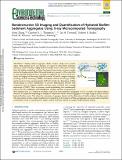Files in this item
Nondestructive 3D imaging and quantification of hydrated biofilm-sediment aggregates using X-ray microcomputed tomography
Item metadata
| dc.contributor.author | Zhang, Naiyu | |
| dc.contributor.author | Thompson, Charlotte E.L. | |
| dc.contributor.author | Townend, Ian H. | |
| dc.contributor.author | Rankin, Kathryn E. | |
| dc.contributor.author | Paterson, David M. | |
| dc.contributor.author | Manning, Andrew J. | |
| dc.date.accessioned | 2019-03-06T11:30:05Z | |
| dc.date.available | 2019-03-06T11:30:05Z | |
| dc.date.issued | 2018-11-20 | |
| dc.identifier | 256751251 | |
| dc.identifier | b519292f-c109-4bf9-9908-d1b3f6e5e147 | |
| dc.identifier | 85056511230 | |
| dc.identifier | 30354082 | |
| dc.identifier | 000451245700039 | |
| dc.identifier.citation | Zhang , N , Thompson , C E L , Townend , I H , Rankin , K E , Paterson , D M & Manning , A J 2018 , ' Nondestructive 3D imaging and quantification of hydrated biofilm-sediment aggregates using X-ray microcomputed tomography ' , Environmental Science and Technology , vol. 52 , no. 22 , pp. 13306-13313 . https://doi.org/10.1021/acs.est.8b03997 | en |
| dc.identifier.issn | 0013-936X | |
| dc.identifier.other | ORCID: /0000-0003-1174-6476/work/51261025 | |
| dc.identifier.uri | https://hdl.handle.net/10023/17226 | |
| dc.description | This research was partially funded by the financial support of a Chinese student scholarship by the China Scholarship Council (CSC), and NERC award, NE/N015703/1. D.P. received funding from the Marine Alliance for Science and Technology for Scotland (MASTS), funded by the Scottish Funding Council (grant reference HR09011) and NERC awards, NE/J015644/1 and NE/1027223/1). A.J.M.’s contribution to this manuscript was partly funded by the HR Wallingford Company Research project ‘FineScale - Dynamics of Fine-grained Cohesive Sediment at Varying Spatial and Temporal Scales’ (DDY0523). | en |
| dc.description.abstract | Biofilm-sediment aggregate (BSA) contains a high water content, either within internal pores and channels or bound by extracellular polymeric substances (EPS) forming a highly hydrated biofilm matrix. Desiccation of BSAs alters the biofilm morphology and thus the physical characteristics of porous media, such as the binding matrix within BSA and internal pore geometry. Observing BSAs in their naturally hydrated form is essential but hampered due to the lack of techniques for imaging and discerning hydrated materials. Generally, imagery techniques (scanning electron microscopy (SEM), transmission electron microscopy (TEM), and focused ion beam nanotomography (FIB-nt)) involve the desiccation of BSAs (freeze-drying or acetone dehydration) or prevent differentiation between BSA components such as inorganic particles and pore water (confocal laser scanning microscopic (CLSM)). Here, we propose a novel methodology that simultaneously achieves the 3D visualization and quantification of BSAs and their components in their hydrated form at a submicron resolution using X-ray microcomputed tomography (μ-CT). It enables the high-resolution detection of comparable morphology of multiphase components within a hydrated aggregate: each single inorganic particle and the hydrated biofilm matrix. This allows the estimation of aggregate density and the illustration of biofilm-sediment binding matrix. This information provides valuable insights into investigations of the transport of BSAs and aggregate-associated sediment particles, contaminants (such as microplastics), organic carbon, and their impacts on aquatic biogeochemical cycling. | |
| dc.format.extent | 3671596 | |
| dc.language.iso | eng | |
| dc.relation.ispartof | Environmental Science and Technology | en |
| dc.subject | Chemistry(all) | en |
| dc.subject | Environmental Chemistry | en |
| dc.subject | NDAS | en |
| dc.title | Nondestructive 3D imaging and quantification of hydrated biofilm-sediment aggregates using X-ray microcomputed tomography | en |
| dc.type | Journal article | en |
| dc.contributor.sponsor | NERC | en |
| dc.contributor.sponsor | NERC | en |
| dc.contributor.sponsor | NERC | en |
| dc.contributor.sponsor | NERC | en |
| dc.contributor.institution | University of St Andrews. Sediment Ecology Research Group | en |
| dc.contributor.institution | University of St Andrews. School of Biology | en |
| dc.contributor.institution | University of St Andrews. Marine Alliance for Science & Technology Scotland | en |
| dc.contributor.institution | University of St Andrews. Scottish Oceans Institute | en |
| dc.contributor.institution | University of St Andrews. St Andrews Sustainability Institute | en |
| dc.identifier.doi | 10.1021/acs.est.8b03997 | |
| dc.description.status | Peer reviewed | en |
| dc.identifier.grantnumber | NE/J015644/1 | en |
| dc.identifier.grantnumber | NE/I02478X/1 | en |
| dc.identifier.grantnumber | NE/N016009/1 | en |
| dc.identifier.grantnumber | NE/J015644/1 | en |
This item appears in the following Collection(s)
Items in the St Andrews Research Repository are protected by copyright, with all rights reserved, unless otherwise indicated.

